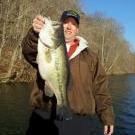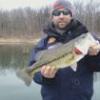I have received a lot of feedback with my last 2 postings so i thought I would share my process. The process is not comfortable for everyone, however I know it works for fall fishing.
I have specific GPS targets I use, but using sonar you can find the fish. This time of year 12 - 15 fow adjacent to a drop off. I'm interested in finding schools of ACTIVE fish. Once found I back my boat up 30 - 50' from the school with the wind to my back and drop my anchor in the deeper water. This is why I look for schools, so I can anchor and catch many fish. You will recognize me on the lake because of using my anchor. I then start casting a 1/4 ounce Kastmaster spoon. I use this spoon because it drops at a predictable 2' per second. I count down on every cast. It is second nature to me so I am almost unaware I'm doing it. This is important because it tells me the depth of the water where my spoon entered the water. I start working left to right, or right to left in about a 120 degree pattern. Always casting and counting. Let it hit bottom. Then start a slow bounce across the bottom back to the boat. 2 turns of the reel, then let it drop for 1-2 seconds. 2 turns of the reel and so on. Once I get a pick up I remember approx. direction of the last cast, and the depth of the water at point of entry. Then I work the heck out of that immediate area. Often i will move 30 - 40' in a different direction to optimize the casts. Sometimes letting it drop to a specific depth is more effective, such as the bottom being at 15' but the count for catching fish is say 5. Obviously, suspended fish or actively feeding fish. Then the fun begins.
Some points to consider. Several locations I have marked produce much larger fish than most of the rest. I don'know why this is but it has repeated itself for several seasons. Some ideal looking structure never produces schooled fish, again I don't know why. If the fish are INACTIVE (laying tight to the bottom) they are not worth the effort of trying to get them to hit. This time of year 3pm to sunset is more productive for me than morning. Once the sun drops below the hills the fish tend to become much less active(angle of the sunlight on shad I believe is significant for feeding). We tend to over think fish. They are primitive and predacious in nature. I have had fish hit my spoon several times until they finally take it. A friend and I were fishing one time together in separate boats and getting hit after hit but could not hook up. It as if all the fish were just playing and not feeding. Hang ups are fairly common but I rarely lose a spoon. If its timber, its old and soft. If caught between rocks usually several attempts at letting the spoon drop frees it. When they are actively feeding is it crazy and hope you don't gut hook the fish cause it takes a lot more time to safely free the hook. Once you locate active fish DONT leave the area. The old saying is worth remembering "don't leave fish to find fish". Following this discipline alone will boat more fish. As mentioned in previous articles I generally fish for 1 - 3 hrs. If I don't catch in the first hour i begin to think about heading in. If the fish are active I generally become bored of catching and releasing after 1 - 2 hours and head back in. By then the thumb is pretty raw. So I'm not sure what would happen if I stayed out for 6-8 hours.
I recently spent a week on Bull Shoals. Hired a guide to catch walleye, but we did not do well. However, a point worth sharing. I was lucky to spot a school of surface feeding Smallmouths. I went over and saw a ton of suspended active fish in 100 fow. It was a fascinating sight to see sooo many fish from 30' to the surface actively feeding. Everywhere fish dispersed throughout that water column. I caught 4 fish real quick. Three were hugh and one respectable. (no pics so I'm not going to say how big the 3 were). And then just as quick the school consolidated and disappeared. This is why we must actively look at the environment on the water. Shad active on the surface feeding. Tight clusters means something different than loosely dispersed clusters. Angle of the sun can be a trigger. Birds feeding is mass can be an indicator. Black bass feed differently on the surface than white bass. Over time you learn to recognize the difference. Wind direction and the effect it has on pushing shad in a direction and how the feeding fish react to this direction.
Anyway I have work to do before I go out again this afternoon.
Till next time








